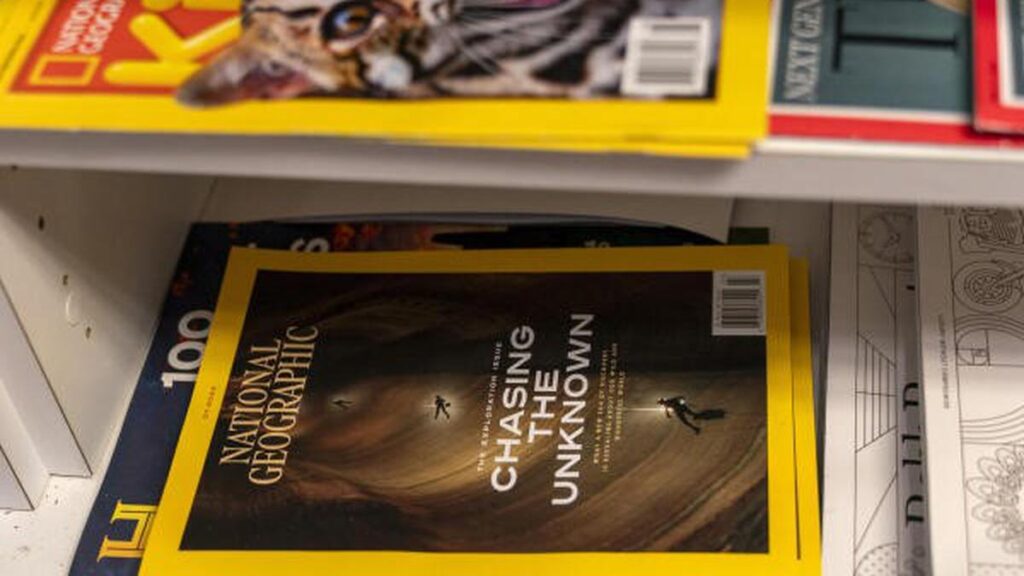The July 2023 edition of National Geographic is for sale at a newsstand in Washington, on Thursday, June 29, 2023.
The National Geographic magazine, the 135-year-old iconic magazine covering science, exploration, the natural world, and culture, no longer has any writers on its staff.
As per reports, anywhere between 17 to 19 editorial positions have been cut in the latest round of layoffs. This includes all the magazine’s staff writers, its tiny audio department and several editors. The layoffs had been announced in April 2023, and staffers were told that their positions would be eliminated in two months.
Others impacted by the latest cost-cutting measures include several photographers, as contracts which enabled them to “spend months in the field producing the publication’s iconic images,” have now been curtailed.
Future editorial work and assignments will be handled by freelancers, and some digital articles will be created by in-house editors. The magazine currently retains two text editors, some digital-only editors and a few multi-platform editors who handle both. A couple of wildlife watch reporting positions, which are funded separately, are still in existence.
Cost-cutting measures by Walt Disney Inc.
This is the second round of job cuts in nine months, and the fourth since 2015. They are a part of cost-cutting measures adopted by media giant Walt Disney Inc., the magazine’s parent company.
In yet another blow, the cost-cutting will also see the magazine, with its legendary yellow rectangle frame border, no longer being sold on US newsstands starting next year, following an internal announcement to this effect last month.
Editorial shuffling and changes have been the order of the day since ownership changes commenced in 2015. In September 2022, a reorganisation of the editorial department saw six top editors lose their jobs.
Responses from Nat Geo and its staff
In a statement shared with CNN, a magazine spokesperson said that National Geographic will continue to publish monthly issues. He said that staffing changes “will not change our ability to do this work, but rather give us more flexibility to tell different stories and meet our audiences where they are across our many platforms.”
“Any insinuation that the recent changes will negatively impact the magazine, or the quality of our storytelling, is simply incorrect.” he added.
The broader world became aware of the layoffs when former writers took to Twitter on Tuesday, June 28. While the magazine did not confirm the news on that day, more tweets from staffers followed the next day.
Some staffers mentioned on Twitter that, while their run may have come to an end, they may stay a little longer to finish up projects.
The National Geographic’s history
The National Geographic magazine has its origins in the National Geographic Society in Washington, founded in 1888 by 33 scientists, researchers and explorers, including Alexander Graham Bell.
At first the magazine was a scholarly journal sent to society members; the first copy published in September 1888, eight months after the society’s founding, did not even have photographs. The 98-page academic volume contained six articles, originally papers presented in Society meetings between February and May 1988. The magazine gradually grew into a publication in its own right, acquiring its distinctive yellow border in 1910. Photographs started appearing in 1905. By the 1930s, it had reached 1 million subscribers. In its heyday in the 1980s, the magazine had 12 million subscribers in the US, and many more overseas.
The publication has won several National Magazine Awards and published work by Pulitzer Prize-winning contributors. It remains a a popular and widely-read magazine in the US. Per the Alliance for Audited Media, the National Geographic magazine had more than 1.7 million subscribers at the end of 2022.
In a report, the Washington Post said that the magazine had been struggling in an “increasingly unforgiving ecosystem,” calling it “an almost artisanal product — a monthly magazine whose photos, graphics and articles were sometimes the result of months of research and reporting.”
Later, the venture also branched into television and videos, with the National Geographic channel and Nat Geo Wild. In 2015, 21st Century Fox took majority control in a for-profit partnership with the National Geographic Society, for $725 million. In 2019, this partnership came under Disney’s control following a $71 billion deal between Fox and Disney.
[ad_2]
Source link

